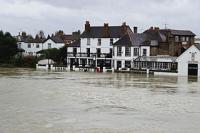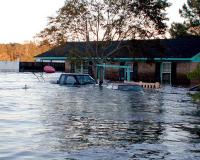-
U.K.: Economic costs from flooding could reach £1.5bn, reduce GDP growth

Economic losses caused by the flooding which has devastated parts of Britain in the past few days could exceed 1.5 billion pounds, and shave 0.2-0.3 percent off GDP growth overall in the first quarter of 2016. Insurers will likely shoulder the bulk of the burden after first Storm Desmond and then Storm Eva saw waters swamp large swathes of the country.
-
-
Better FEMA options for increasing the affordability of flood insurance

FEMA currently does not have the policy analysis capacity or necessary data to comprehensively analyze different options for making flood insurance more affordable. A new report identifies an approach for the Federal Emergency Management Agency (FEMA) to evaluate policy options for making premiums through the National Flood Insurance Program (NFIP) more affordable for those who have limited ability to pay.
-
-
U.S. coastal flood risk on the rise ten years after Hurricane Katrina
A decade after Hurricane Katrina caused $41 billion in property and casualty insurance losses, the most expensive catastrophe ever experienced by the global insurance industry, rising sea levels are driving up expected economic and insurance losses from hurricane-driven storm surge in coastal cities across the United States. Rising sea levels contributing to increased risk of severe economic damage from flood following a hurricane – and Miami, New York, and Tampa now face greater risk than New Orleans.
-
-
Community-based flood insurance offers benefits, faces challenges
Community-based flood insurance — a single insurance policy that in theory would cover an entire community — may create new opportunities to reduce flood losses and enhance the likelihood of communities paying more attention to flood risk mitigation, says a new National Academies report. This option for providing flood insurance, however, would not provide the sole solution for all of the nation’s flood insurance challenges.
-
-
2014 uncertainty over renewal of Terrorism Risk Insurance Act changed consumer behavior
Terrorism insurance take-up rates dropped off toward the end of 2014, due to the anxiety stemming from the unexpected expiration of the Terrorism Risk Insurance Program Reauthorization Act (TRIPRA). Through much of 2014, there was uncertainty whether Congress would renew the program, which initially passed in the wake of the 9/11 terrorist attacks. This uncertainty led customers, and potential customers, to change their insurance buying plans.
-
-
Tying insurance rates to flood risk for low-lying structures
Current methods used by the National Flood Insurance Program for setting risk-based insurance rates do not fully capture the flood risk for low-lying structures, which are more likely to incur losses because they are subject to longer duration and greater depth of flooding and are flooded more frequently and by smaller flood events, says a new report from the National Research Council. The report offers alternative approaches for calculating risk-based premiums for these structures, ranging from incremental changes to current methods to a complete overhaul of the system, although it does not recommend which approach the NFIP should adopt or what the new rates should be.
-
-
Underwriters of cyberinsurance policies need better understanding of cyber risks
Demand for insurance that covers an ever-increasing range of cyberattacks is growing and evolving rapidly, and a number of insurance companies are seeking advice through sponsored events that can gradually educate their work forces. At Standard & Poor’s Rating Services 2015 Insurance Conference last week, a panel of insurance experts stressed the importance of insurance underwriters gaining a better understanding of cyber risks in order to make better property and risk assessments.
-
-
Overstretched global food system vulnerable to disruptive shocks: Lloyd's report
The vulnerability of the overstretched global food system to sudden shocks, and the wide repercussions for communities, businesses, and governments was highlighted yesterday by a report published by Lloyd’s. The reports highlights the far-reaching economic and humanitarian consequences that disruptions such as weather catastrophes or plant pandemics – many of which are exacerbated by climate change — could have on the global economy. This series of shocks has the potential to trigger food riots in urban areas across the Middle East, North Africa, and Latin America, leading to wider political instability and knock-on effects for a wide range of businesses.
-
-
National Flood Insurance Program to focus more on victims’ needs
Roy Wright, the newly appointed director of the National Flood Insurance Program (NFIP), said that he will push it to better focus on the welfare and individual needs of disaster victims, following years of scandal within the organization. Wright, who will preside over the federal program beginning this week, criticized the insurance loopholes and complicated rules of private insurance companies that were perpetuated by the NFIP to “nickel-and-dime” policyholders and undermine their abilities to rebuild following a flood.
-
-
FEMA considering overhauling the National Flood Insurance Program
Federal legislators and officials with the Federal Emergency Management Agency (FEMA) are trying to overhaul the National Flood Insurance Program which relies on eighty-three companies to sell policies, collection premiums, and calculate damages after disasters. The program covers roughly 5.2 million homes and businesses nationwide. The move comes just as FEMA is in talks to settle almost 1,800 lawsuits filed by homeowners claiming they were underpaid on flood insurance claims after Superstorm Sandy. The flood insurance program was launched in 1968 after private insurers increased their coverage prices due to newer risk assessments, leaving most homeowners unable to afford them.
-
-
To bolster the world’s inadequate cyber governance framework, a “Cyber WHO” is needed
A new report on cyber governance commissioned by Zurich Insurance Group highlights challenges to digital security and identifies new opportunities for business. It calls for the establishment of guiding principles to build resilience and the establishment of supranational governance bodies such as a Cyber Stability Board and a “Cyber WHO.”
-
-
Philippines mulls issuing catastrophe bonds to cover costs post-typhoon rebuilding
After Super Typhoon Haiyan ravaged the Philippines in 2013, killed at least 6,300 people and inflicting $13 billion in damage, the Philippine government is now looking at mitigating the costs of rebuilding and protection through catastrophe bonds. The bond sale would help the country with the rebuilding costs and should cover the cost of any future disasters on the same scale as Haiyan. Just last year, the World Bank had issued catastrophe bonds relating to earthquake and cyclone risks in sixteen Caribbean countries.
-
-
Rising sea level-induced floods cause increase in flood insurance rates
Long-term sea level rise has made tidal flooding a near-daily event in many cities, compared to 1950 when it occurred about once every two years. As sea level rises, threatening more homes along flood zones, flood insurance claims are expected to increase. The Homeowner Flood Insurance Affordability Act of 2014 (HFIAA), which went into effect on 1 April, means that primary homeowners would see an average 10 percent increase in flood insurance premium yearly, along with an extra $25 annual surcharge. Secondary owners of vacation houses and condominiums can expect about an 18 percent rate increase, plus a $250 annual surcharge.
-
-
Options for providing affordable flood insurance premiums
The National Flood Insurance Program (NFIP) within the Federal Emergency Management Agency (FEMA) faces dual challenges of maintaining affordable flood insurance premiums for property owners and ensuring that revenues from premiums and fees cover claims and program expenses over time. A new report found that these objectives are not always compatible and may, at times, conflict with one another. The report discusses measures that could make insurance more affordable for all policy holders and provides a framework for policymakers to use in designing targeted assistance programs.
-
-
Oklahoma warns insurers not to deny claims for man-made-earthquake damage
Oklahoma Insurance Commissioner John Doak is warning insurers about the practice by some insurance companies to exclude “man-made” earthquakes from their policies without clear intent. Some companies are marking quakes caused by waste water injection wells — or “fracking” — as “man-made” and therefore outside of the scope of coverage of policies. This denial of coverage follows a dramatic increase of tremors in the state since 2013. The increase in fracking activity in the state has been accompanied by a dramatic increase in the number of earthquakes: Last year, the Oklahoma Geological Survey identified 567 tremors at or above a 3.0 magnitude, the point at which such quakes can be felt by humans and cause property damage.
-
- All
- Regional
- Water
- Biometrics
- Borders/Immig
- Business
- Cybersecurity
- Detection
- Disasters
- Government
- Infrastructure
- International
- Public health
- Public Safety
- Communication interoperabillity
- Emergency services
- Emergency medical services
- Fire
- First response
- IEDs
- Law Enforcement
- Law Enforcement Technology
- Military technology
- Nonlethal weapons
- Nuclear weapons
- Personal protection equipment
- Police
- Notification /alert systems
- Situational awareness
- Weapons systems
- Sci-Tech
- Sector Reports
- Surveillance
- Transportation
Advertising & Marketing: advertise@newswirepubs.com
Editorial: editor@newswirepubs.com
General: info@newswirepubs.com
2010-2011 © News Wire Publications, LLC News Wire Publications, LLC
220 Old Country Road | Suite 200 | Mineola | New York | 11501
Permissions and Policies
Editorial: editor@newswirepubs.com
General: info@newswirepubs.com
2010-2011 © News Wire Publications, LLC News Wire Publications, LLC
220 Old Country Road | Suite 200 | Mineola | New York | 11501
Permissions and Policies
